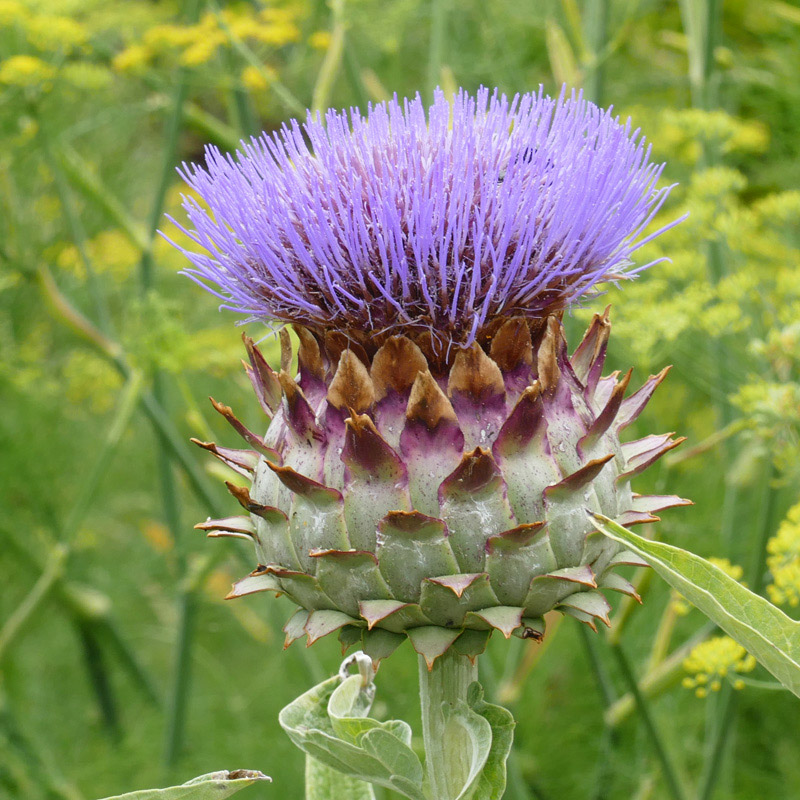Botanical name
Cynara cardunculus L. [Syn. C. cardunculus var. scolymus (L.) Benth.]
Family
Asteraceae
Common name
Globe artichoke, French artichoke, Green artichoke, Artichoke thistle
Information about the plant
The artichoke was probably introduced to Europe by the Arabs at the same time as its name, Cynara, and has become established in the Mediterranean area as far as the Canary Islands. In Central Europe, it could not establish itself as a wild plant due to its non-hardy nature. Nowadays, it is only known to us as a cultivated plant, grown as a vegetable in the Mediterranean region and in Central Europe. The plant material for medicinal use comes exclusively from leaf crops grown in controlled conditions in Europe, mainly Central Europe; leaf material from harvested vegetable crops is of inferior quality.
The artichoke is a composite plant with a slightly thistle-like habit. This is expressed in the species name, as the Latin cardunculus means small thistle. Its large leaves are one to two pinnate, either with or without spines, forming a basal rosette. They are pale green on the upper side and have soft felt-like hairs on the underside. The leafy stems, up to 1.5 m tall, bear 1 to 3 large flower heads (8 to 15 cm in diameter). Countless purple tubular flowers stand on the fleshy, flat receptacle. They are surrounded by numerous bracts arranged like roof tiles with a fleshy base, the edges of which are fringed or have a thorny, pointed appendage. Ray florets are not present. The fleshy receptacle and the fleshy base of the bracts of the still-closed flower are a popular delicacy when cooked.
Medicinally used parts of plants (herbal drug)
The dried leaves of artichoke leaf crops (Artichoke leaves - Cynarae folium) are used, as well as the fresh plant pressed juice of the artichoke flowers that have not yet bloomed.
Leaf cultivations are found in Franconia, Brandenburg, and Thuringia regions, as well as in Brittany; importations are also from southern and southeastern European countries.
Constituents of the herbal drug
Artichoke leaves contain caffeoylquinic acids (including chlorogenic acid), flavonoids, and sesquiterpene bitter compounds.
Quality of the drug
The quality of the following drugs or drug preparations is specified in the European Pharmacopoeia (Ph. Eur.): Artichoke leaves (Cynarae folium), artichoke leaves dry extract (Cynarae folii extractum siccum).
Medical applications
Recognised medical use
The HMPC has classified artichoke leaves as a traditional herbal medicinal product (see Traditional Use).
Indications for use supported by clinical studies (authorization): dyspeptic complaints, especially in functional disorders of the bile ducts.
ESCOP: digestive disorders (e.g., stomach ache, nausea, vomiting, feeling of fullness, flatulence) and hepatobiliary disturbances; adjuvant to a low-fat diet in the treatment of mild to moderate hyperlipidemia (elevated blood lipid levels).
Traditional use
Artichoke leaves have been classified by the HMPC as a traditional herbal medicinal product (§ 39a AMG). Based upon long-standing use, artichoke leaves can be used for the symptomatic relief of digestive disorders such as dyspepsia with a sensation of fullness, bloating, and flatulence.
Herbal drug preparations in finished dosage forms
Dry extracts from dried artichoke leaves in capsules and coated tablets; also dissolved in liquids.
Dry extracts of fresh artichoke leaves in capsules, tablets and coated tablets (dragées); aqueous extract in liquids.
Fresh plant pressed juice of artichoke buds as juice.
Dosage
Finished dosage form: see patient information leaflet.
Tea infusion: drink a cup of artichoke leaf tea before meals; daily dose: 3 to 6 g of the herbal drug.
Preparation of a tea
Pour 150 ml of hot water over 1.5 g of finely chopped artichoke leaves and strain after 10 min.
Notes
Artichoke leaves must not be taken in the presence of bile duct obstruction and gallstones or liver disease, nor in the presence of an allergy to Compositae (potential cross-allergy).
There are no safety studies on the use of artichoke leaves during pregnancy and lactation; use in children under 12 years of age is not recommended due to lack of data.
Side effects
Very rarely mild diarrhea and associated upper abdominal discomfort, nausea, and heartburn.
Interactions
None known
References
Herbal drug monographs
HMPC (2019), ESCOP (2009), WHO vol. 4
Further literature
Commentary on the European Pharmacopoeia (Artichoke leaf, Nr. 1866; Artichoke leaf dry extract, Nr. 2389)


